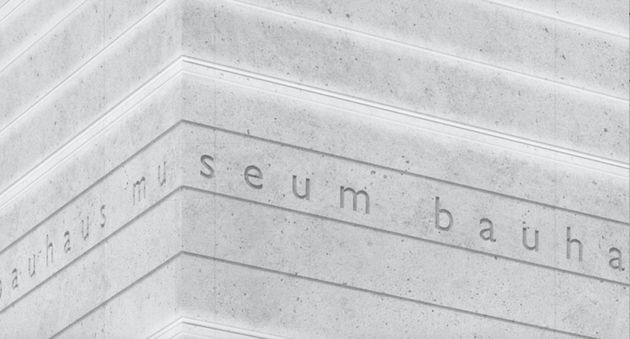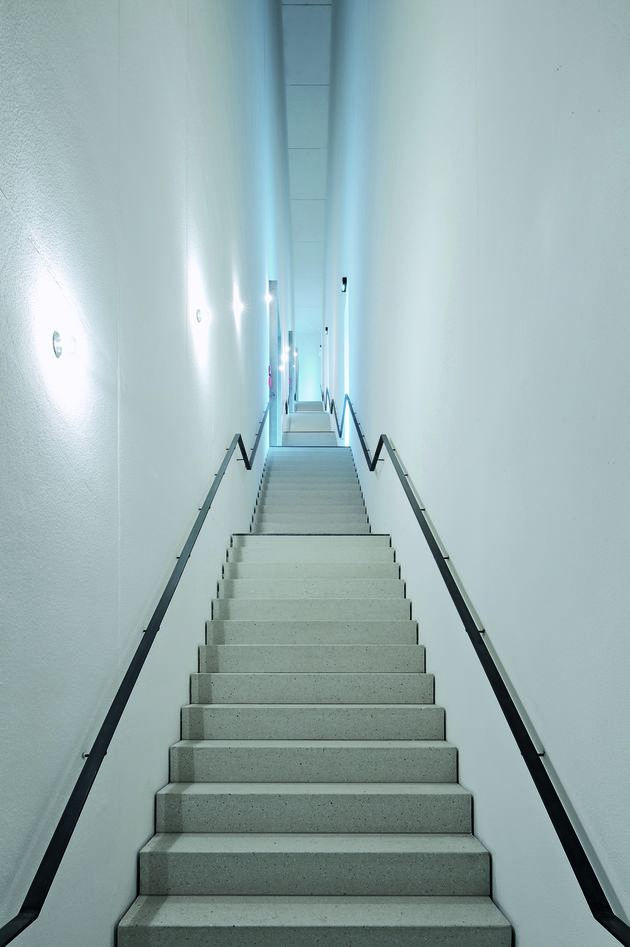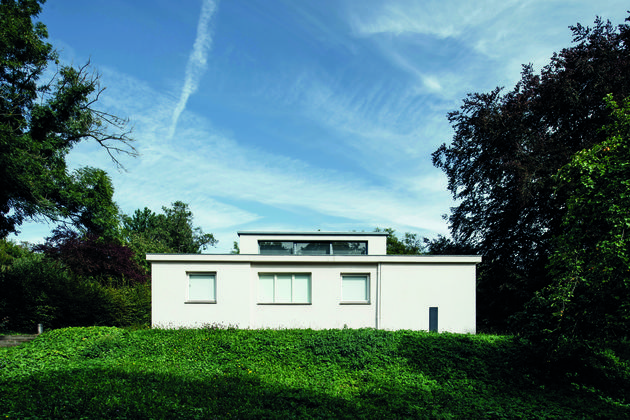 Visualisation of the detail on the front of the Bauhaus Museum in Weimar. Image courtesy of the Heike Hanada Laboratory of Art and Architecture
Visualisation of the detail on the front of the Bauhaus Museum in Weimar. Image courtesy of the Heike Hanada Laboratory of Art and Architecture
In the centenary year of the design movement’s founding, the new Bauhaus Museum in Weimar is just one of multiple tributes reassessing the school’s historic legacy
This year, you will see the Bauhaus everywhere, from sunglasses inspired by Marcel Breuer to furniture that purportedly expresses the simplicity – a word chosen carefully for its nebulousness – of Bauhaus design. Of the swaths of Bauhaus tributes the world has been inundated with of late, among the most far-reaching was the Google Doodle of 12 April, which attracted scrutiny on Twitter from the likes of design critic Alexandra Lange for bringing to life some of the most celebrated Bauhaus creations through a scrolling animation that was more de Stijl than it was Bauhaus.
The most interesting aspects of the centenary allow us to understand its well-worn history in more nuanced ways. One example is the new Bauhaus Museum in Weimar that displays a collection of early Bauhaus specimens begun by Wilhelm Kohler in 1919, when he obtained a copy of the Bauhaus journal Der Austausch for the state art collection. Thanks to acquisitions and donations, the collection now comprises 13,000 objects. Although some are already entrenched in Bauhaus mythology, the objects have never been unified in a single archive before. This has allowed the curatorial team to create a fresh narrative around the birth of the school, which casts it as very much a local history because all the objects are from Weimar. But it sets them within broader themes, such as the Bauhaus preoccupation with the ‘New Man’, a new way of being that the Bauhaus strove for after the horrors of the First World War.
 Visualisation of the southeast elevation of the Bauhaus Museum from the terrace. Image courtesy of the Heike Hanada Laboratory of Art and Architecture
Visualisation of the southeast elevation of the Bauhaus Museum from the terrace. Image courtesy of the Heike Hanada Laboratory of Art and Architecture
The story told by the building itself – designed by Heike Hanada, an architect and professor at the Bauhaus University in Weimar – is more unexpected. Its monolithic concrete cuboid form, devoid of windows, is more akin to rationalist architecture – a pared-back form of neoclassicism developed in Italy – than it is to any familiar articulation of Bauhaus design, with an interior that is equally severe. A set of stairs slices through the three floors of the building, forming a vertiginous diagonal cut that you can look down through from the top stair. At the upper landing is a window looking out over the countryside, where you can just make out a tower atop a hill. It is part of a memorial designed by Fritz Cremer that marks Buchenwald, one of Germany’s largest former concentration camps.
Had Hanada wished to create a typical Bauhaus building, the ideal precedent could have been found in Weimar itself, where the first piece of Bauhaus architecture can be found: the Haus Am Horn, a domestic house designed by Georg Muche for the 1923 Bauhaus exhibition. Instead, she has chosen to design a structure whose edifice draws attention to an aspect of Weimar’s past that is often overshadowed in anecdotal accounts of the Bauhaus’s successes. It reflects on the fact that the movement wasn’t just founded in Weimar, but that it was also the place it fled from when it moved 80 miles north to Dessau in 1925, having been driven out by repeated attacks from the fledgling Nazi Party.
 The Himmelsleiter inside the museum. Photo by Andrew Alberts, courtesy of the Heike Hanada Laboratory of Art and Architecture
The Himmelsleiter inside the museum. Photo by Andrew Alberts, courtesy of the Heike Hanada Laboratory of Art and Architecture
‘I think this was, for us, the most important fact,’ says Hanada. ‘It was for the city as well, as they decided to place the museum not in context to the original site where the Bauhaus was founded, but in direct connection with the so-called Gauforum which was built by the Nazis.’ The U-shaped complex of colonnaded buildings comprising the Gauforum, standing adjacent to the museum, was built by the National Socialist party as its local headquarters, and now serves as government offices. It would be easy to miss the fact that the square at the centre, which now connects to an underground car park, was once called Adolf Hitler Platz and used as a site for propagandist rallies. The echo of Weimar’s darker history in the fabric of the new museum is an important reminder of how this area was once used. It is also a reminder, as nationalist parties rise in Europe, that tolerance isn’t to be taken for granted.
Many other towns and cities across Germany are marking the centenary of the Bauhaus. There will be lectures, exhibitions and even a golf tournament to celebrate the tradition of playfulness instilled by Johannes Itten, one of the first Bauhaus teachers, who gave a lecture in 1919 in which he used the phrase: ‘Our game. Our party. Our work. And in that order.’ The Weimar museum is one of three that will open this year, along with a new building in Dessau by Barcelona architects González Hinz Zabala, and an extension to the existing Bauhaus archive in Berlin by local practice Staab Architekten. An international exhibition and research project under the umbrella Bauhaus Imaginista rereads the cosmopolitan conditions of the Bauhaus from a transnational perspective. It involves an exhibition in Berlin accompanied by a series of international events located in ten cities, from Hangzhou, China to Rabat, Morocco.
 Visualisation of the lounge inside the museum. Image courtesy of the Heike Hanada Laboratory of Art and Architecture
Visualisation of the lounge inside the museum. Image courtesy of the Heike Hanada Laboratory of Art and Architecture
One aspect of Bauhaus history that has certainly begun to be read more critically is its gender dynamics. Until recently, male figures at the centre of the Bauhaus were the most feted, such as Gropius, Hannes Meyer and Mies, the school’s successive leaders. But new accounts of the Bauhaus significantly redress the gender imbalance. Books published this year, including Bauhausmädels: A Tribute to Pioneering Women Artists, and Bauhaus Women: A Global Perspective, account for the work of designers such as Marianne Brandt and Anni Albers, but also lesser-known women who were highly skilled, such as ceramicist Margarete Heymann and theatre designer Ilse Fehling, who have otherwise receded into the margins of history.
There is also a greater consciousness of the fact that although the Bauhaus school enrolled women, there was a hidden agenda on the part of Gropius to reduce the number of female students, and women’s work was generally limited to certain crafts such as weaving.
 The Haus Am Horn, designed by Georg Muche. Photo by Tillmann Franzen
The Haus Am Horn, designed by Georg Muche. Photo by Tillmann Franzen
To avoid diluting the complexity of Bauhaus history, it is worth remembering that the school existed at a time of social turmoil that was no less complex than the present, when the charisma of László Moholy-Nagy was powerful but not infallible, the treatment of women was improving but not equal, and the free-thinking spirit of learning was massacred by the far right.
If there is one lesson that contemporary design can draw from the Bauhaus 100 years on, it is surely that if we want design to flourish, we will have to fight for space in which radical ideas can develop. The conditions of history never were, and never will be, perfectly ripe for change, and unless we allow new ways of working to emerge, it will become ever less likely that in another 100 years, there will be another design movement with a centenary anywhere near as momentous.
To read the full version of this article, get your copy of Icon 193, the July 2019 edition
















